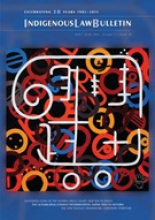May/June 2011 Volume 7 Issue 24

Editorial
Welcome to the May-June edition of the Indigenous Law Bulletin (‘ILB’). This general edition provides a diversity of articles looking at issues such as tenancy issues in the Northern Territory, Native Title issues in Victoria, Circle Court experiences in New South Wales and ways of protecting Intellectual Property across the country.
Housing issues in the Northern territory have been widely publicised and discussed as part of the Northern Territory Emergency Response. The Northern Australia Justice Agency (‘NAAJA’) critically examines the new tenancy framework for remote Indigenous communities highlighting some of the problems currently being experienced. In their article The New Tenancy Framework for Remote Indigenous Communities in the Northern Territory NAAJA calls for a specialised tenancy service to advise remote tenants.
Katie O’Bryan provides valuable insight into the Victorian Native Title case of the Gunaikurnai people. O’Bryan provides insight into the Intra-Indigenous dispute with the Kurnai Clans, the process of negotiation with the state and the impact that the state election had on settlement negotiations. Also in Victoria, Richard Frankland, Muriel Bamblett and Peter Lewis provide a summary of This is Forever Business: A framework for Maintaining and restoring Cultural Safety in Aboriginal Victoria. The paper calls for a ‘cultural landscape that is respectful, equitable, honourable and therefore culturally safe’.
Kathleen Daly and Gitana Proietti-Scifoni outline the findings of their qualitative study of Aboriginal offenders and the Circle Court. The Elders Know...the White Man Don’t Know offenders’ views of the Nowra Circle Court provides a detailed sketch of the Nowra Circle Court from the perspectives’ of offenders.
In the field of intellectual property and copyright, Jeremy Morse examines the importance of an international regime on access and benefit sharing in his paper Nurturing nature, Nurturing Knowledge. The Nagoya Protocol on Access and Benefit Sharing. WhilstTami Sokol considers the legal developments in Indigenous copyright protection and proposes an administrative and constitutional way forward.
Also in this edition Yogeswaran Subramaniam reviews the book The Orang Asli and the UNDRIP: from Rhetoric to Recognition. The review examines the experiences of Malaysia’s Indigenous people whilst highlighting what Australia can learn from their experiences. The reviewer calls for Australia ![]() to move beyond the symbolic and implement the United Nations Declaration of the Rights of Indigenous People.
to move beyond the symbolic and implement the United Nations Declaration of the Rights of Indigenous People.
This edition concludes with an interview with June Kenny who is one of the first Indigenous Managing Directors of a major Western Australian Law Firm.
April Long
Editor
CONTENTS
Nurturing Nature, Nurturing Knowledge: The Nagoya Protocol on Access and Benefit Sharing by Jeremy Morse
The Gunaikurnai Consent Determination: Is this the High Water Mark for Native Title in Victoria? by Katie O’Bryan
The New Tenancy Framwork for Remote Aboriginal Communities in the Northern Territory by Nadia Rosenman and Alex Clunies- Ross
The Elders Know...the White Man Don’t Know: Offenders views of the Nowra Circle Court by Kathleen Daly and Gitana Proietti-Scifoni
An Unworkable Reconciliation? Indigenous Artistic works and the Copyright Act 1968 (Cth) by Tami Sokol
Forever Business: A framework for maintain and restoring cultural safety in Aboriginal Victoria by Richard Frankland, Muriel Bamblett and Peter Lewis
Book Review: The Orang Asli and the UNDRIP: from rhetoric to recognition by Yogeswaran Subramaniam
An interview with June Kenny by April Long
Archives of the ILB from Volume 1, Issue 1 (1981) to 7 (4) 2009 are available online at http://www.austlii.edu.au/au/journals/AboriginalLB and http://www.austlii.edu.au/au/journals/ILB/.
